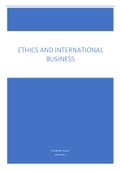Summary
Ethics and International Business Summary
- Course
- Institution
- Book
In this document you will find a summary of the theory for the course 'Ethics and International Business' given in the second year of the Bachelor's degree in International Business and the Pre-Master Finance. The summary includes key theory, persons, and examples from the book.
[Show more]





